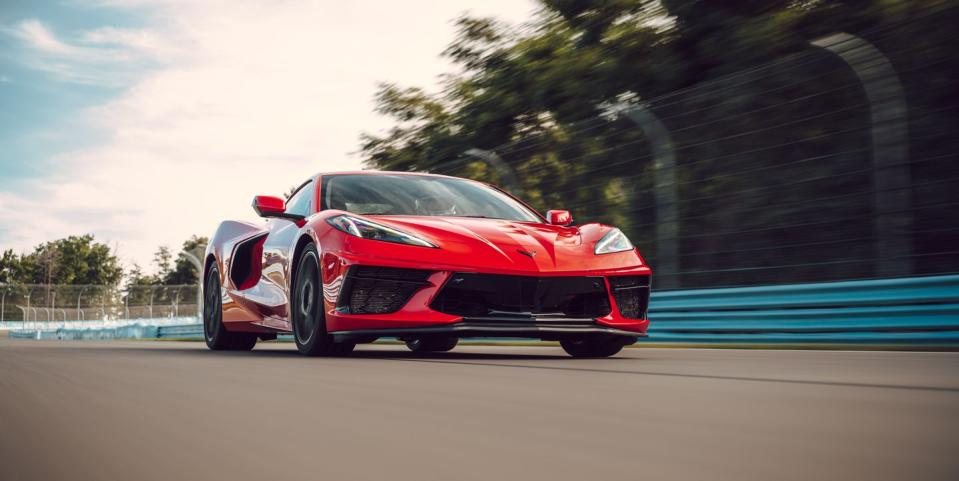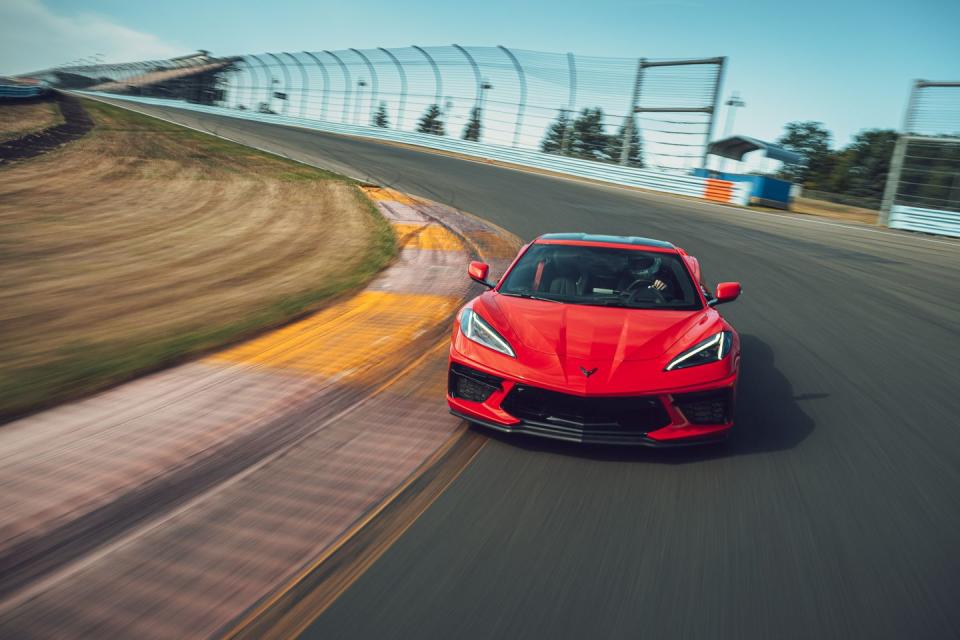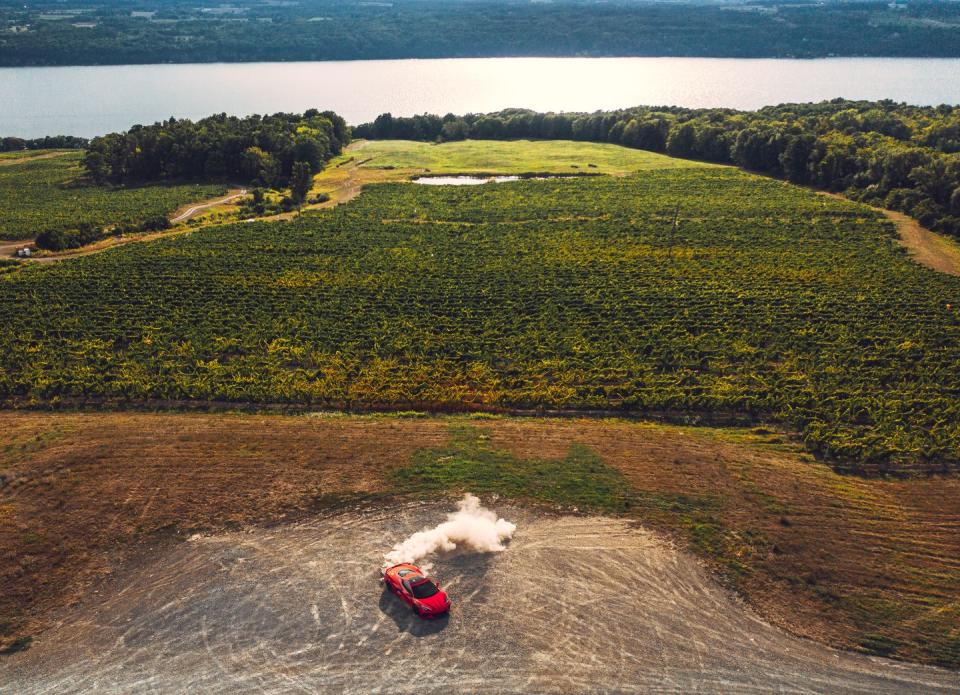The 2020 Chevy C8 Corvette Proves the Small-Block V-8 Will Never Be Outdated

The spiritual home of the sports car in North America isn’t Detroit. It’s not Southern California. It’s not even Bowling Green. It’s upstate New York, specifically Watkins Glen. A tiny American town with an outsize reputation.
From the November/December 2020 issue of Road & Track.
After World War II, sports cars followed returning service members to America. Lithe, light, and low-powered,they were the antithesis of the American way of travel. Cameron Argetsinger, a Watkins Glen local, saw an opportunity. In 1948, he staged the first Watkins
Glen road race, an event that became an annual showcase of the country’s bravest drivers on challenging country roads. In 1951, legendary General Motors designer Harley Earl attended the race to show off a concept LeSabre and was inspired to build a purely American sports car. In 1953 he came back to the race with his creation: the Corvette.

The first generation wasn’t quite up to its world-beating task. But through seven generations and more than 65 years, the Corvette evolved into a car that did everything a Porsche or a Ferrari could for less than half the price. It’s one of few cars at home in every possible environment. It’s underrated to the point of disdain by those who simply don’t want to believe that an American sports car can beat the hell out of models from Europe.
Part of that may be the working-class price. Another may be the lackluster interiors. The biggest knock may have been the perception that the engine was in the wrong place. And for decades, rumors insisted that the Corvette’s V-8 would move behind the driver. It was always just about to happen, with a string of mid-engine concept cars giving credence to the rumors. But a series of false starts, including one C7-generation plan scuttled by bankruptcy, saw hopes continually fall. Until now.

The C8-generation Corvette is easily the most anticipated American car of the last 20 years, one with impossibly high expectations from customers, journalists, and GM itself. It must be a grand tourer, sports car, track car, drag racer, and golf-club hauler, displaying versatility not expected of any other model. That’s the Corvette’s dilemma: Because it has doubters, it must to do everything flawlessly.
Our first drive of the C8 for Performance Car of the Year saw us get behind the wheel of a preproduction model, one not 100-percent finalized. At the time, it seemed the Stingray was very good but best considered as a building block for higher-powered versions of the car to come, variants that would truly take advantage of the mid-engine architecture.
But the completed car stands on its own. This is the performance bargain of the century.

Like the Corvette, Watkins Glen has evolved. Racing moved from public roads to a purpose-built facility decades ago, but the track is no less daunting. This circuit hosted the Formula 1 United States Grand Prix for two decades and still sees professional sports-car racing each year. It’s one of the old-school tracks, iconic blue barriers lining a course carved out of the land by men on tractors, not mere algorithms. What you get is a gorgeous, flowing track, a fast 3.4-mile goliath as intimidating as it is iconic. This is where we reacquaint ourselves with the C8.

It gets you the first time you push the start button, the familiar small-block bark smacking your brain from behind, the unrefined lope a brief reminder that you’re not in something from Europe. The new engine, dubbed LT2, is an evolution of the V-8 we saw in the C7, now producing 495 hp and 470 lb-ft of torque with the Z51 package. That gets it to 60 in 2.8 seconds, better than the last-generation Z06 and ZR1, cars with at least 150 more horsepower.
The C8 gives the illusion of ever-present grip. It’s a rear-wheel-drive car with an almost all-wheel-drive character, able to fire in any direction at any time. That acceleration from a dig is thanks to the mid-engine layout and aggressively short gearing from the eight-speed, dual-clutch gearbox. Corvette chief engineer Tadge Juechter said shifting weight toward the rear axle would allow the C8 to put more power down, hence the move to a mid-engine layout. Perhaps the C7 Stingray and Grand Sport had no traction issues; the C8 has less than none.
You do lose the dance of clutch, accelerator, and steering, of making sure you have the right mix to stay straight. On the track, going for lap times, that’s undeniably a good thing. But losing that theater is noticeable on the road, where instead of worrying about controlling the rear end, you need to worry about hitting imprisonable speeds within seconds of touching the throttle.
Unlike Corvettes past, the controls are delicate, with light steering and paddle shifters. A sign of modern trends. While it was a sad day when the Corvette lost its third pedal, the gearbox has vastly improved since we first drove the car months ago.
Shifts from the Tremec-designed transmission are crisp and rapid in manual mode, thanks to paddles wired directly to the box. Downshifts are quick and perfectly rev-matched, when you get them. That’s one annoyance. In a heavy braking zone, like into Turn 1 at The Glen, you’re snagging gears quickly. Occasionally the gearbox takes more than one pull to react, likely because a paddle was pulled before the engine was ready to allow a shift. Instead of delaying that shift slightly, the gearbox denies it, then forgets you ever asked. Exercising more patience with the paddle results in delay-free downshifts. Driven in automatic, it’s telepathic, keeping the engine in the powerband at all times and banging off shifts without issue.
Chevrolet has recently compared Corvette automatics to Porsche’s PDK gearbox, and every single time Chevy’s automatic has been a letdown. The PDK is still the best you can buy, but this Tremec is leagues better than any automatic ever fit to a Corvette, a half-step at most behind the best.

WATKINS GLEN
Tucked in the hills just outside the hamlet that bears the same name, Watkins Glen International is one of America’s greatest and most challenging tracks.
1. TURN ONE
A fast right. Get your braking done beforehand, hit an early apex, and use all the track for the fast run up the esses.
2. THE BUS STOP
The place to be brave. Brake late and clobber the curbs. The Vette was touching 150 before the braking zone.
3. THE BOOT
Quicker than it looks. Use the track’s compression to get back to power early, maximizing that short straight.
4. THE TABLETOP
Secretly the most challenging turn on track. An off-camber left, get this one wrong and you’ll end up in the wall.

 Yahoo Autos
Yahoo Autos 